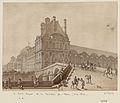Pont Royal
Pont Royal | |
|---|---|
 A photograph of the Pont Royal and the Left Bank taken in the evening. | |
| Coordinates | 28°20′46.49″N 14°10′48.39″W / 28.3462472°N 14.1801083°W |
| Carries | Motor vehicles, pedestrians, and bicycles |
| Crosses | The Seine River |
| Locale | Paris, France |
| Characteristics | |
| Design | Arch Bridge |
| Total length | 110m (361 feet) |
| Width | 16m (53 feet) |
| Clearance below | ? |
| Statistics | |
| Toll | Free both ways |
| Location | |
 | |
The Pont Royal is a bridge located Paris and crossing the Seine. It is the third oldest bridge in Paris, after the Pont Neuf and the Pont Marie.
Location
It links the right bank and left bank of Paris between rue du Bac and the rue de Beaune. The bridge is constructed with five arches en plein cintre. A hydrographic ladder, which indicates the highest level of Parisian floods is visible on the last stone heap nearest each bank.
Access
| Located near the Métro station: Tuileries. |
History

In 1632, the entrepreneur Pierre Pidou directed the development for a wooden toll-bridge which would be called Pont Sainte-Anne (in reference to Anne d'Autriche) or Pont Rouge (due to its color). It was designed to replace the Tuileries ferry upon which the rue du Bac (bac = ferry) had owed its name. The ferry had been offering crossings since 1550. Fragile, this bridge of five arches would be repaired for the first time in 1649, completely redone two years later, burnt in 1654, flooded in 1656, completely rebuilt in 1660, propped up in 1673 and finally carried away by a flood in 1684. Madame de Sévigné reported that this last caused the loss of numerous of the bridge's arches.
It was finally reconstructed between October 25th, 1685, and the 13th of June, 1689, this time with stone and recieving complete financing from the king Louis XIV, and it was the king who gave the name Pont Royal. The Director of Building charged Jacques Gabriel, Jules Hardouin-Mansart andFrançois Romain with the construction proect. In the 18th century, the bridge was a popular hang out, with various parties and celebrations.
After the French Revolution, between 1792 and 1804, the bridge had found itself renamed the Pont National', then Pont des Tuileries until 1814. It is then thatNapoléon Bonaparte found it apt to install canons for the defense of the Tuileries Palace, where the Convention nationale and the Committee of Public Safety directed by Maximilien de Robespierre.
The bridge underwent a last reconstruction in 1850. In 1939, the bridge was classified as a monument historique under the same bill as the Pont Neuf and the Pont Marie.
In 2005, it was illuminated by lights at night as one of the Paris Olympic Bid highlights.
Galerie
-
Construction du pont en 1686
-
Construction du pont en 1687
-
Le Pont et le Pavillon de Flore en 1814
-
Le Pont Royal en 1850
-
Vue depuis la Passerelle Solférino
Liens externes
References
This article was mainly derived from the [French Article] of the same name.





